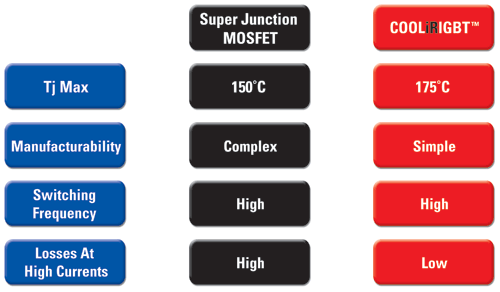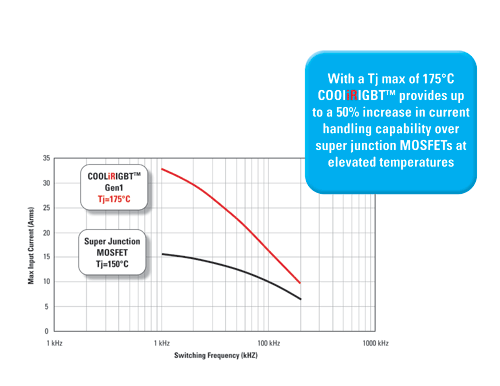Cool alternative to switching power at high speed
New automotive-specific technologies are needed to drive long-term sustainable, rugged, reliable, and low-cost solutions
BY BENJAMIN JACKSON
Senior Manager, Automotive Power Switch Product Management & Business Development
International Rectifier
www.irf.com
In high-voltage, high-current applications, one particular power semiconductor device has triumphed over all others; this is the insulated gate bipolar junction transistor, more conveniently known as the IGBT. Typically, when considering power semiconductor solutions, the power MOSFET is the first point of call, but the IGBT has an inherent advantage over a MOSFET — it is a bipolar junction device, this means it can both block high voltages effectively and conduct high currents. Indeed, an IGBT becomes more efficient than a power MOSFET at higher currents, but sadly like all technologies there is a tradeoff, for the IGBT this comes in the form of relatively low switching speed. Traditionally, an IGBT may only switch up to 40 kHz, thereby restricting it to motor control applications, switching power supplies were strictly off limits for the IGBT, this was the home of the super-junction power (SJ) MOSFET, a device capable of switching into the hundreds of kilohertz and sustaining high voltages.
Over the last few years a new field of high-voltage and high-current applications has emerged, applications requiring high-voltage, high-frequency power semiconductors with benchmark performance, faultless robustness and reliability and at low price point. Hybrid electric vehicles are the place where such devices are needed, particularly in the battery charger and dc/dc converter applications. Due to the combination of high voltage and switching frequency (typically >100 kHz) super-junction MOSFETs were the natural choice. Today a family of such devices rated around 600 V is available on the market, capable of effective supporting power levels up to a few kilowatts. However, the super-junction MOSFET has several limitations compered with an IGBT; these are outlined in Fig. 1 .

Fig. 1: A comparison of super-junction MOSFETs and ultra-fast switching IGBTs
Firstly, a super-junction device is limited to a maximum junction temperature of 150C. This is due to the fundamental nature of how the device is constructed, with many layers and process steps the structure of a SJ MOSFET inherently “leaks” in electrical terms, particularly at higher temperatures. This is not the case with an IGBT, which has much improved leakage performance, so much so that the device can be rated at 175C. This may seem a subtle differentiator, but in the automotive market the requirement for semiconductors capably of high Tj max values is a must. By going to a high Tj reliability can be improved, cooling system cost reduced, or simply traded off for more power and system cost reduction.
In a similar token the complex nature of the super-junction MOSFET is frequently felt in the pocket of the end customer. Processing methodologies vary from manufacturer to manufacturer but typically an SJ MOSFET takes around twice as many process steps as a state-of-the-art IGBT to produce. This is directly reflected in the high price many of these components can command.
Of course one limitation of the IGBT is the fact that the bipolar structure does not, unlike a MOSFET, have an internal body diode. To provide a body diode feature, semiconductor manufactures frequently “co-pack” a dedicated diode inside the IGBT package, connected in parallel between emitter and collector. On face value, this may seem as a big limitation for the IGBT, but this is only half the story. The body diode of the SJ MOSFET is far from ideal. Seasoned applications Engineers will confirm that the body diode in SJ MOSFETs is more often than not snappy and fragile resulting in difficult design considerations at a board level and poor EMC performance. Arguably, there have been great improvements in the body diode over the last few years, but it remains a constant battle to improve the body diode without compromising the performance of the MOSFET. Therefore, with an IGBT, it is possible for manufactures to select an optimal diode, robust and rugged, and indeed the cost of packaging a separate diode in with the IGBT is still more cost effective than an equivalent super-junction device.
Despite its high cost, the super-junction device has a unique blend of performance: high voltage, high-current capability, and high frequency. Until now, despite the limitations of the super-junction MOSFET, the switching losses of the IGBT prevented it from being a true contender in high-frequency applications, it was just too slow. The Engineers at International Rectifier, however, were inspired by the IGBTs ability to deliver better condition loss performance than a MOSFET. While the bipolar junction may be slow, it does deliver lower losses at higher currents (see Fig. 2 ).

Fig. 2: A comparison of effective on state resistance of super-junction MOSFET vs. an ultra-fast IGBT
Exploiting this fundamental benefit that the IGBT has over a MOSFET and optimizing the switching performance the engineers at IR were able to produce a new high-voltage, high-power, and high-frequency technology called CooliRIGBT Gen 1. These 600-V devices are built on a thin wafer technology and are optimized for switching frequencies up to 200 kHz, a range covering most automotive battery charger and dc/dc converter applications. Most importantly these new IGBTs couple the high-speed nature of a MOSFET with the inherent efficiency of a bipolar junction at high voltages and currents. The result is a device that can deliver 50% higher current than an SJ MOSFET while operating at a 16% higher junction temperature. Figure 3 shows this mix of benefits.

Fig. 3: Current handling capability of a like for like SJ MOSFET and CooliRIBGT device
The amount of ongoing product development in the automotive industry related to hybrid and electrical vehicle systems is unprecedented. However, a key limitation of these new electrical systems compared to their mechanical, engine driven forefathers is their relatively high expense and limited power density. To truly drive hybrid and electric vehicle adoption a change in power semiconductor technology is needed. Simply upgrading and squeezing industrial technologies like the super-junction MOSFET into automotive sockets will have limited and short returns. To drive long term sustainable, rugged, reliable and low cost solutions new automotive specific technologies are needed. CooliRIGBT Gen 1 is one such technology, delivering higher junction temperature and efficiency and lower cost compared with the incumbent solutions, while still being designed, qualified and manufactured to automotive standards. Already pioneers in the field of automotive battery chargers and dc/dc converters have made the switch from MOSFETs to ultra fast IGBTs, establishing such devices as the new benchmark for high-voltage, high-power, and high-frequency power switches. ■
Advertisement
Learn more about International Rectifier





